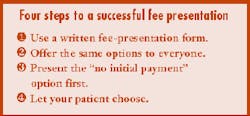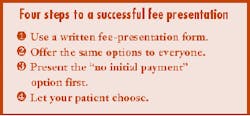Case acceptance - the key to growth
by Bill Brady
If you develop an ideal treatment plan for your next 10 patients, how many of them will say "yes" and proceed with the best dentistry you can provide? Do you even track this vital information in your practice? This is one of the most significant numbers in your practice, because it serves as an indicator for a number of things.
Let's go back to the initial question: Out of 10 patients, how many accept treatment? Two? Four? Does your staff know the number? Do you know? If your answer is two or four, it should be seven or eight. If it was four, that means six patients left your office without any plans to return for treatment.
This number can indicate that your examination may not be as complete as it should be. It can be an indicator of how well you and your staff communicate - or don't communicate - with your patients. It can be an indicator of your presentation skills or how well you prepared for the treatment conference. Did you help the patient find a way to pay for the treatment you recommended?
If you don't know, then perhaps this article will highlight the single, most effective way to grow your practice - increasing your case- acceptance rate!
I'm sure you have heard before that the average practice has over $1 million worth of production in its patient records. Looking back, imagine if you could have proceeded with the ideal treatment plan for most of your patients. What would that have done for your practice's profitability?
First of all, how do you determine your case-acceptance rate? If you have two out of 10 patients proceed with your ideal treatment plan, then your case-acceptance rate is 20 percent. You must keep track of how many cases you present and then how many patients accept the treatment you recommend. Usually, I call a case accepted when the treatment begins or when a payment has been made. You can track this on a computer or by hand in a notebook. The important point here is to track it and be accurate about it.
If eight out of 10 patients do not proceed with treatment, do you know why they don't? We have found that, in most cases, the answer is financial. Patients may not indicate a financial barrier upfront because they are guarding their privacy, but that often is the real answer.
Case-acceptance rate
So why is it important to track your case-acceptance rate? There are several reasons, but let's highlight a few of them.
- These are high-profit, high-margin cases for you.
- You will practice more efficiently by not dragging out treatment over time to suit a patient's budget or insurance considerations.
- Your patient will enjoy a better and more efficient clinical experience.
- Your sharp focus on case-acceptance rates will motivate your staff to focus on this area, producing benefits for your practice.
The most important factor in increasing your case-acceptance rate is to understand that your patients' first financial concern is not the amount of the fee. Their first concern is how they will pay for it.
Let me share my experience in orthodontics, where treatment fees range from $3,500 to $5,000+ for a single case. Most orthodontists have been closely tracking their case- acceptance rates for several years. An average orthodontic practice has an acceptance rate of 60-70 percent. However, many top-tier practices are in the 80-90 percent range.
Similar constraints exist for an orthodontic practice. The fee is high. For most patients, it is a major purchase. We also need to remember that patients have choices, including seeking a second or third opinion.
What do orthodontists do to obtain high case-acceptance rates, given these constraints? The key is how the payment choices are presented to the patient. Remember, the biggest barrier for most patients is financial, and their most important concern is how to pay for treatment.
When we began working in the orthodontic field, there was no standard format in the profession for presenting the fee and the payment choices. Each practice developed its own style and most needed improvement. Case-acceptance rates were at lower "underachieving" levels.
Over the course of several years, a format was developed that incorporated the best of what was found in the most successful practices. Today, 40 percent of the orthodontists in the country are using the standardized fee-presentation format and case-acceptance rates are steadily increasing.
Presenting the fee
The effective fee-presentation format is a science, not an art. If your staff follows a few simple steps every time you present a comprehensive treatment plan, you will greatly increase your case-acceptance rate.
1. Use a written fee-presentation form. Make the presentation clear and simple for both you and your patients. Let your patients see exactly what their options are in writing. They will understand and retain more, making it easy for them to decide which option works best for them.
A written form also will ensure presentation consistency among staff members. If a patient later calls with questions about her fee, all of the answers will be on one form. Should your patient want to discuss finances with a spouse, she can bring home one simple form that contains all of her payment information.
2. Offer the same options to everyone. If a staff members asks your patient, "How would you like to pay, by check or credit card?" you are losing patients for financial reasons. Given these limited options, many patients quietly panic and postpone their decision. These patients walk out and may not come back. Presenting two to three options will address nearly everyone's needs and maximize your case-acceptance rate.
Today, everyone expects to be given payment choices when making large purchases, and many people prefer to spread payments over time instead of making a lump-sum payment. Don't be quick to judge a patient's financial situation. The nice car a patient is driving could be leased and that patient may prefer to spread payments to you over time as well. Conversely, the patient who doesn't look affluent could be able just to write you a check. You never know!
3. Present the "no initial payment option" first. Put your patients at ease. Begin by letting them know that they can start treatment without the need for an initial payment. Once you've eliminated the financial barrier, your patients will listen attentively to their other options. Those patients who prefer to pay you in full right away will do so, but no matter what option they choose, patients will appreciate you for making treatment easy and affordable for them.
4. Let your patient choose. Once you've presented all of the payment options, ask your patient: "Which of these options works best for you?" Your patient will choose which option is best for his or her situation.
By following these four simple steps, you will see your case-acceptance rates for your ideal treatment plan increase significantly. Your target should be 70-80 percent, and you can measure this each day by having your staff track case acceptance. Tracking and monitoring is an important exercise, since it will keep your focus - and your staff's focus - on this critical area for growth.
Remember, in the final analysis, your patient makes the decision whether to proceed with your ideal treatment plan. The best way to make this decision easy is to give your patients attractive payment choices.
With the right payment choices presented in the right way, your patient's mindset will quickly change from "Can I afford this?" to "When do we begin?"

